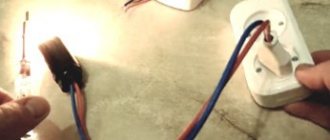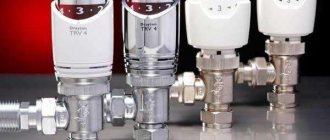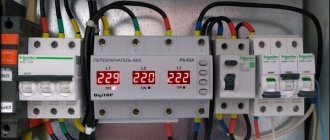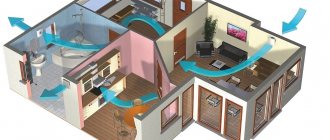It is unwise to turn on lighting in some rooms or outdoors for the entire dark period. To ensure that the light turns on only when needed, a motion sensor is installed in the lamp’s power circuit. In the “normal” state, it breaks the power circuit. When a moving object appears in its coverage area, the contacts close and the lighting turns on. After the object disappears from the coverage area, the light turns off. This operating algorithm has proven itself excellent in street lighting, in lighting utility rooms, corridors, basements, entrances and stairs. In general, in those places where people appear only periodically. So, for savings and convenience, it is better to install a motion sensor to turn on the light.
Where used, types
Products come in several types - ceiling, wall and for hidden installation. They are also conventionally divided into several types according to the principle of operation (we will discuss this in more detail below).
When choosing, consider the installation location. Sensors are divided into household and street lighting.
In the latter case, materials are used that protect the device from negative natural influences. It can be connected on the stairs or on the street. Household devices are designed for installation inside the house.
Depending on the circumstances, sensors that monitor movement can be connected to a spotlight, lamps, or even an Arduino smart home.
The main device manufacturers are ERA, Evan, TDM, LLT, Orbis, Duwi, Camelion, Brennenstuhl, Elektrostandard, FERON, REV, REXANT, Rubetek and others.
Installation recommendations
Practice has shown that the best place to place LED strips is the ceiling or its joints with the walls. This way, the lighting strips are less likely to get dirty and exposed to dust and moisture. In addition, it is better to place the tape itself in a kind of transparent case for protection, unless, of course, it was originally equipped with one.
It is best to place the entire part related to powering devices from a 220 V line - batteries, converting units, contactors separately in a special cabinet. From which, using thin wires designed for 12V current, supply electricity to the light strips. At the same time, it is also advisable to protect them by hiding them in a box or hiding them under decorative elements of the furnishings.
Characteristics
When purchasing a motion sensor, it is important to consider a number of parameters, which determine the features, connection location, and conditions for use.
Main characteristics when choosing:
- WEIGHT. Modern light sensors weigh from 25 to 240 g.
- Maximum load power. When choosing a product, you need to look at the permissible load. Thus, one sensor can switch devices with power from 60 to 2300 W. Please note that when using more powerful devices, it may be necessary to replace the wiring or install a machine with a higher rated current.
- VOLTAGE. The operating voltage varies in a wide range from 1.5 to 220 Volts. Conventionally, motion sensors are divided into several groups - 1.5 V, from 2.2 to 3.6 V, 220 V, 5 or 9 V.
- MAXIMUM VIEWING ANGLE. Here the range is from 30 to 360 degrees. In the latter case, the device operates along the entire perimeter of the room.
- RANGE. The minimum and maximum distance parameters are 8 and 120 m. Here you need to take into account the object on which lighting is provided. You should not choose sensors with an excessively high parameter, because they can react to the movement of strangers.
- RECOMMENDED INSTALLATION HEIGHT. Here the permissible parameter ranges from 1.2 to 16 m.
- PRESENCE OF LED INDICATOR. Some sensors are equipped with an LED that starts blinking when a signal is present. Other LED display options are also possible.
These are the main characteristics that you need to consider when purchasing. We will discuss the selection criteria in more detail below.
Types of motion sensors
To classify devices, we define two main factors: the presence and type of sensor device, as well as installation features.
The main element in the circuit breaker under consideration is a motion sensor. There are several varieties of it, based on different physical laws.
In all cases, the result is the same: when an object appears in the controlled area, the sensor is triggered and the contacts of the circuit supplying the lighting devices are closed.
The most common motion sensor is infrared - it does not emit anything, is relatively cheap and can be installed not only indoors, but also outdoors
Motion sensors for automatically turning on and off lights are:
- Acoustic.
- Infrared.
- Ultrasonic.
- Microwave.
The first two categories of sensors belong to passive devices; they do not emit anything. The detectors of the two remaining varieties are active devices. These options send waves of various lengths into the room, and by the nature of their reflection they determine the presence or absence of new objects in their coverage area.
Equipment of the “active” class with an emitter and receiver is more expensive than “passive” models. The devices are more complex in design, but have a low level of false alarms. Passive devices in this regard are much inferior to their active counterparts, but are cheaper than their competitors.
Acoustic sensors are triggered by the sounds of doors opening, the clicking of heels, and simply sharp claps. This option is best taken for corridors of public buildings.
It is also ideal as an addition to other sensors, so that the light can be turned on by clapping your hands. It is not recommended to install it alone in a private house. There will be too many false reactions to various sharp sounds.
Infrared sensors are designed to be triggered by human heat. But they also react to animals and heated radiators. They must be carefully configured, and the coverage area must be set so that radiators do not fall into it. This is the simplest, most durable and cheapest touch sensor for automatic light control.
Operating principle of ultrasonic sensors. Ultrasonic and microwave sensors are similar in operating principle, they only have a different range of emitted waves
Sensors operating by emitting microwaves and ultrasound are not recommended for installation in residential premises. A person is not able to feel their impact, but it is there, but there is definitely no benefit from it. It has been noticed that domestic animals often react to this radiation in a sharply negative manner.
Such emitters are more suitable for parking lots or open areas. At the same time, active motion sensors also have a limited range.
When organizing control over a large area of ultrasonic devices, you will have to install a lot. Plus, many of them only work during sudden movements. A slowly walking person may completely “fall out” of their field of action.
The ideal option is a combined sensor with several methods of detecting people entering the controlled area. It is more reliable and less likely to trigger erroneously. However, you will have to pay a lot for this accuracy, since such sensors are obviously more expensive than conventional analogs.
Scheme and principle of operation
There is a large selection of sensors on the market that react to movement and allow you to configure the switching on of lighting on different objects. When purchasing such devices, it is necessary to take into account the presence of several types.
Infrared
The products sense the heat emitted by the human body. The main element is a sensor with a Fresnel lens installed on it, which reacts to the approach of heat and bridges the contact group.
Operating principle:
- the radiation is focused into a narrow beam of light and directed to the sensor;
- the sensor detects the signal, receives it and gives a command to operate.
Such devices are conventionally divided into passive and active. In the first case, the response occurs to a change in temperature conditions, and in the second, the operation occurs in the event of a signal interruption.
Operating principle and design
The operating principle of an LED lamp with a motion sensor is based on lighting the light in response to the appearance of a moving object in the controlled area. At the same time, detection itself can be carried out in various ways - infrared, ultrasonic and microwave. In most cases, IR sensors are used. They work on the property of any body to emit heat waves and function according to the following algorithm:
- A moving object appears in the field of view.
- Infrared radiation from it reaches the receiver - the Fresnel lens.
- Concentrating heat waves hit the IR sensor.
- The triggered sensor element sends a signal to the control unit.
- The power module supplies electrical current to the LED lamp and it lights up.
- If the movement of the object in the observation field is not repeated, after a specified period of time (as configured) the power is interrupted and the light goes out.
A lamp with a motion sensor is sometimes equipped with a photo relay. Thanks to it, the sensor begins to work only when natural light deteriorates below a certain level. This is done so that the lamp does not turn on during the day, but only at dusk and at night.
Perfect examples of LED lamps in this category have a built-in motion sensor. According to the installation method, such a lighting device is no different from a standard light bulb with an E27 socket - it just needs to be screwed into a socket of the appropriate size. At the same time, their external body is made in the form of a lantern, lampshade, chandelier and other lamps.
Unlike halogen and fluorescent analogues, which are also sometimes equipped with detectors, ice lamps are complemented by a wide variety of additional equipment:
- Photo relay.
- Controller.
- Block for adjusting brightness, sensitivity, operating time.
- Fuses against short circuit and overheating.
Regardless of the configuration, LED lamps with a motion sensor have a number of advantages:
- Ensuring autonomy of lighting switching.
- Versatility of use.
- Variety in power.
- Long service life due to frequency of operation.
- Possibility of adjusting the sensor by angle, time, sensitivity.
- Saving more than half of the energy spent on lighting.
- Aggregation with an alarm system.
Criterias of choice
When purchasing a presence sensor to turn on the light, it is important to consider a number of criteria regarding installation and operation features.
Let's highlight the basic recommendations:
- DECIDE THE PLACE FOR INSTALLATION. For outdoor installation, it is advisable to choose devices with protection from IP 55 and higher (preferably from 65). If the product is mounted under a canopy and protected from water, the IP degree is suitable. If the motion sensor is planned to be installed inside, for example, to turn on lighting in a house, apartment or garage, there are no special requirements for the degree of protection.
- CONSIDER POSSIBLE OBSTACLES (WALLS). The most commonly used sensors are sound or infrared sensors. Microwave products are more suitable for security purposes.
- DECIDE YOUR VIEWING ANGLE. If the entrance to the room where the lighting is being adjusted is possible from several points, it is advisable to choose a sensor with a 360-degree angle and mounted on the ceiling. If there is only one passage, 180 degrees is enough.
- DECIDE ON POWER. Before purchasing a device, consider the consumption of the devices that will be connected to it. Sum up the resulting values and add 10-20% on top for reserve.
- CONSIDER YOUR ACTION RADIUS. For a small room, a minimum parameter of 6-10 meters is sufficient. To work over a large area, it is better to choose sensors with a large radius.
- PLEASE BE AWARE OF THE PRESENCE OF ANIMALS. If there are pets in the apartment or in the yard of the house that can affect the sensor, it is better to take devices with special protection.
- PAY ATTENTION TO THE PRESENCE OF A PHOTO RELAY. This is a big plus, because in this case the product turns on only in the absence of light.
We will pay special attention to the choice of lighting devices:
- When installing the sensor outdoors, use LED spotlights, which can easily withstand temperature changes and place less stress on the wiring.
- In open areas, it is better to use lamps that operate on the luminescent principle.
- When organizing driveway lighting, you can use all types of lamps, but in order to save money, it is better to choose the LED option.
Knowing the features of choosing a motion sensor and lighting elements, it is easier to make the right purchase and not make a mistake with the choice.
Basic installation diagrams
There are several schemes for connecting a switch and an external motion sensor to the power circuit of lighting devices. In general terms: the sensor is inserted into a wire break with a phase. There are three terminals on its body. The corresponding cores of the power cable are connected to “L” and “N”, and from the third terminal the wire is sent to the lamp.
The simplest circuit with a motion sensor, but without a key switch - the light will turn on only from the sensor built into the device
If one automatic detector is not enough and you also need a manual way to turn on the lighting, then the “key” can be connected to the circuit in two ways. In the first, such a switch is inserted into the phase wire going to the sensor from the panel. When it is open, the sensor simply does not work and does not supply voltage to the light bulb.
The second option involves inserting a switch into the line from the phase to the input to the electric lamp. When such a “key” is closed, the light will remain on even if the sensor does not work.
Two diagrams with different methods of connecting a key switch to a circuit with a load (electrical lighting device) and a motion sensor
If you need to install several detectors, they are connected to each other in parallel. The power wire goes to the lamp from each of them. Light will appear when any of the sensors is triggered. If this solution seems unnecessarily complicated, it is better to purchase light bulbs with a built-in motion sensor.
If the lighting device is powerful or there are several of them, then a magnetic starter with an amplifier should be installed in the circuit instead of a light bulb. And through it, power a separate lighting circuit. In this case, you can choose a low-power and cheaper detector.
Most energy-saving lamps quickly burn out when the voltage is turned on and off frequently. Therefore, connecting them via a motion sensor is not always advisable, since they will fail too often. The resulting savings from using such light bulbs will be zero.
To avoid problems with expensive lamps burning out, after the motion sensor, it is necessary to install a protection unit with soft switching on of the light in front of them. Due to the absence of sudden changes in voltage in the electrical network, light bulbs will not “burn” as often as without such a protective device.
The following article will introduce you to the markings and rules for selecting smart switches, which we strongly recommend reading.
How to connect for lighting: on the stairs, in the apartment, on the street
There are five different connection schemes for lighting control. Let's look at the features of each option and common mistakes.
Circuits without a switch
To begin with, let's highlight circuit solutions that do not involve the use of a switch.
Two-wire connection
This is the simplest option, which involves the use of several elements - a 220 V circuit breaker, a sensor, a junction box and a lighting source). The principle of assembling the circuit is the same as when installing a lamp.
First, power is supplied to the indicator, and through it is directed to the lamp. It is better to assemble the chain in an individual circuit, rather than in a general lighting chain.
A simplified diagram is shown below.
Using this method, you can connect motion sensors to turn on the lights on the stairs, in an apartment or other object.
The action algorithm looks like this:
- Place a cable with three cores and a 1.5 square wire into the junction box and label the wires (indicate the phase, ground and neutral wires).
- Stretch two wires to the installation site of the control product, which gives the command to turn on the lighting.
- Place the device at a height of 120-200 cm from the floor. When installing, make sure that it does not interfere with the opening of doors or other mechanisms. It is not recommended to install near heating elements.
- Also place the cable that goes to the light source in the box.
- Connect all the wires using special terminal blocks - phase, neutral and ground.
- Connect the wires to the sensor. Place the phase on the terminal with L, and the second wire (from the lamp) on the load symbol.
- Finish the installation by installing the box and setting it up. Set the automatic mode, operating time interval and sensitivity level.
Adjustment (setting)
After installation, the motion sensor must be configured to turn on the light. There are small rotary controls on the body to adjust almost all parameters. They can be turned by inserting your fingernail into the slot, but it is better to use a small screwdriver. Let us describe the adjustment of a DD-type motion sensor with a built-in light sensor, since they are most often installed in private homes to automate street lighting.
Tilt angle
For those sensors that are mounted on walls, you first need to set the angle of inclination. They are mounted on rotating brackets, with the help of which their position changes. It must be selected so that the controlled area is the largest. It is impossible to give exact recommendations, since it depends on the vertical viewing angle of the model and on the height at which you hung it.
Adjusting the motion sensor begins with selecting the angle of inclination
The optimal installation height for the motion sensor is about 2.4 meters. In this case, even those models that can cover only 15-20° vertically control sufficient space. Adjusting the incline is a very rough name for what you'll be doing. You will gradually change the angle of inclination, check how the sensor works in this position from different possible entry points. It's not difficult, but it's tedious.
Sensitivity
On the body this adjustment is labeled SEN (from English sensitive - sensitivity). The position can be changed from minimum (min/low) to maximum (max/hight).
Basically, the settings look like this
This is one of the most difficult settings, since it determines whether the sensor will work on small animals (cats and dogs). If the dog is large, it will not be possible to avoid false alarms. With medium and small animals this is quite possible. The setup procedure is as follows: set it to minimum, check how it works for you and for inhabitants of smaller stature. If necessary, increase the sensitivity little by little.
Delay time
Different models have different shutdown delay ranges - from 3 seconds to 15 minutes. You need to insert it the same way - by turning the adjusting wheel. It is usually signed Time (translated from English as “time”).
Glow time or delay time - choose what you like best
Everything is relatively easy here - knowing the minimum and maximum of your model, you can approximately choose a position. After turning on the flashlight, freeze and note the time after which it will turn off. Next, change the position of the regulator in the desired direction.
Light level
This adjustment relates to the photo relay, which, as we agreed, is built into our motion sensor to turn on the light. If there is no built-in photo relay, it simply will not exist. This adjustment is labeled LUX, the extreme positions are labeled min and max.
They can be located on the front or back side of the case
When connecting, set the regulator to the maximum position. And in the evening, at the level of illumination when you think the light should already turn on, turn the regulator slowly to the min position until the lamp/lantern turns on.
Now we can assume that the motion relay is configured.
How to avoid false positives
To avoid false switching on of lighting in the circuit solutions discussed above, follow these tips:
- Do not place sensors near trees or heating devices.
- Always break only the phase.
- Make sure that light rays, for example from an incandescent lamp, do not penetrate to the sensor.
- Attach the product depending on the type (wall, ceiling).
- Do not install the device near air conditioners or windows where there is air movement.
- Make sure that the glass of the infrared product is clean and undamaged.
Following the above tips allows you to quickly and without errors connect a device to control lighting on the stairs, in an apartment or on the street.
Comfortable night lighting of the corridor
It is recommended to plan lighting in an apartment at the stage of rough work, when the floor covering has not been completed. To do this, you need to know the types of lighting and understand their features.
Types of lighting in the apartment:
- General;
- Accent;
- Working;
- Night.
General lighting is a light source that illuminates the entire room. It is done in any room: a chandelier is hung in the center of the ceiling. General lighting can be mixed, diffused and directional. Mixed lighting - the use of chandeliers with lampshades that have holes at the top or bottom. Such lampshades are made from materials that transmit light, which allows light to penetrate through the lampshade in all directions and be pressed away from the walls and ceiling. Diffuse lighting is obtained from shades made of frosted glass, paper or fabric, which completely cover the light source.
Accent lighting (decorative) is used to draw attention to certain interior elements or parts of the room: paintings, niches, shelves, stucco molding. Floor lamps, sconces and lighting are used for this. The function of this type of lighting is to create comfort and decorate the apartment.
Working lighting helps a person not to strain their eyes when performing any actions. This light is used above work surfaces in the kitchen, near the sofa or armchairs in the living room, and near the desk. The light sources here are table lamps, sconces, and built-in lamps.
Night lighting is an optional, but very convenient type of lighting that allows you to ensure safe movement around the apartment at night. An option for such lighting could be illumination of the ceiling along the perimeter of a room or corridor, a luminous LED path on the floor of the hallway or on the wall, or night lamps in the nursery.
Corridor lighting is necessary, first of all, in those apartments where families with children live. The child will not be afraid to get up at night and go to the toilet on his own, and parents will not have to worry that in the dark he will hit something and injure himself.
For night lighting of the corridor use:
- Lamps with motion sensor;
- Glowing baseboard;
- LED lamps built into walls or floors;
- Switches with illuminated frame or buttons;
- Glowing floor modules;
Lamps with a motion sensor are also called twilight switches. Such a lamp is a device that automatically responds to the movement of an object. It is triggered when a person enters the room and “turns on” the light. Such devices are simple and easy to install, comfortable, functional and help save a lot of electricity. Motion sensors are usually installed at a level of 20-25 cm from the floor. The glow time of the device and the sensitivity of the sensor are adjustable.
Illuminated switches differ from ordinary ones only in that they have backlight indicators installed, which help to find their location in complete darkness.
How to connect to a spotlight
Another issue that requires consideration is how to properly connect a motion sensor to a floodlight.
To do this, you can use one of the following schemes:
- WITH THREE CONTACTS. In this case, the phase is supplied from the shield to terminal L. From output A, the wire goes to the input L of the spotlight. Voltage is supplied when the motion sensor is triggered. Contacts N are combined and directed to the shield. The ground is sent directly to the spotlight and connected to the PE to remove possible voltage from the metal housing.
- USING A SINGLE KEY SWITCH. In the solution discussed above, the use of a switch is not provided. But this can be fixed. As a rule, the switch is mounted in a phase break (before the product that controls the movement). In this case, when the switch is turned off, the voltage is removed from the entire circuit. The second option for connecting the switch is parallel to the phase and the output of the motion sensor. With this solution, you can turn on the lighting without being tied to other devices. When the switch is turned off, the entire circuit operates as usual.
- USING A TWO-KEY SWITCH. In this case, a certain symbiosis of the two circuit solutions discussed above is introduced. One contact of the switch breaks the phase, and the second comes in parallel. When both buttons are disconnected, the voltage is completely removed from the circuit. When the first key is turned off, the sensor operates in normal mode and turns on the spotlight when movement occurs. If only the second key is activated, voltage is immediately applied to the lamp.
- TWO SENSORS. The same principle applies here as discussed above. Two movement-controlling organs are arranged in parallel, after which they are connected to the power circuit and the spotlight.
- CONNECTING THE LAMP TO A LOWER VOLTAGE. If it is necessary to turn on the spotlight at a lower voltage (12, 24 or 36), a power supply is installed in front of the input, reducing 220 V to the required level. In this case, three wires (with ground) are supplied to the power supply input; only power is sent to the sensor.
- FOR A SEPARATE PHOTO RELAY. When installing old motion controllers without a photo relay, the latter must be connected separately. In this case, the wire goes from the output of the sensor to the relay, and after that to the input of the spotlight. The zeros are combined and the ground goes towards the light source.
Above are the basic diagrams that allow you to connect a spotlight with or without a switch. Here everyone makes a decision taking into account the current tasks and characteristics of the room.
Advantages and disadvantages
Light switching devices with sensor provide the following advantages:
- Economical energy consumption. All devices have automatic controllers, thanks to which the lights turn off when there are no people in the room.
- Convenient operation. The main advantage of remote control is that there is no need to directly press the switch button. This is very convenient in a dark or too large room.
- Functionality. Modern modifications operate wirelessly. If necessary, the devices are connected to electrical household appliances (computer, TV, etc.).
Such devices are not without their disadvantages:
- High prices. You have to pay extra for comfort, convenience and functionality.
- Labor-intensive installation. Although the device can be installed by a non-specialist, you need to have certain skills and knowledge in the field of electrical engineering.
How to connect to Arduino
Of no less interest is connecting a motion sensor to Arduino to organize a smart home.
To solve the problem you need to prepare:
- Arduino board;
- PIR motion control device;
- solderless breadboard;
- 220 Ohm resistance and LED;
- wires of the male-male and male-male types.
The name of the contact connections may differ from one manufacturer to another, so before performing work it is necessary to study the features of the module.
One pin is connected to GND, the next to VCC (5 V), and the remaining one to OUT (transmits a digital signal from the PIR sensor).
PIR sensors are almost identical in design. They have the necessary sensitivity at a distance of up to six meters, and visibility is 110*70 degrees. The output appears 0 or 1 depending on whether the fact of movement is detected.
How does a lamp with a sensor work?
There are 4 types of lamps with DD, the operating principles of which are discussed below.
With infrared sensor
This device consists of four main parts:
- Light source
- Motion Sensor
- Relay
- Fresnel lens
The sensor is configured to detect vibrations in the infrared spectrum produced by a body that emits heat. It is easy to determine the presence of a living object in the field of view, since in the infrared range it will “glow” in comparison with surrounding cold objects. However, the rays are highly scattered. In order to “collect” them and direct them to the photocell of the sensor, a Fresnel lens is used.
Power supply to the lamp is provided by a relay, the contacts of which close when the photocell detects presence. When a warm object is detected, the IR sensor voltage is increased and the relay is activated.
There is a timer inside the relay that is activated when the object creating the radiation disappears from the sensor’s field of view. The average shutdown time is 2 minutes.
The disadvantage of lamps with an infrared sensor is their low sensitivity. IR rays best reach the photocell when the body generating them is mobile. If the object does not move, then the photocell may miss them.
Also, do not forget that it is not only living objects that emit heat. Batteries, stoves, stoves - all this can cause false alarms of the sensor.
With ultrasonic sensor
The operating principle of this device is not very different from lamps with an IR sensor. It does not include a Fresnel lens and a photocell. However, there is a generator and receiver of low-frequency waves.
The generator creates low-frequency sound radiation that is not perceptible to the human ear. The waves are constantly reflected from objects surrounding the sensor and returned to the receiver. The return time of the waves is recorded. When a moving object appears, the return time of the waves will vary depending on how closer it approaches the generator (the closer the object, the shorter the return wave). When a change in wavelength is detected, the lamp is triggered.
When an object disappears from the sensor's visibility range, the time relay is activated and begins counting. After 2-3 minutes, the device opens the contacts and the lamp goes out.
Disadvantages of ultrasonic sensors:
- Negative effects on animals
- Narrow coverage radius
With microwave sensor
This type of device is more convenient to use, as it can “see” objects located behind walls and ceilings. A lamp with a microwave sensor works on the same principle as an ultrasonic one. The only difference is that it is not sound waves that are emitted, but electromagnetic waves that are able to pass through obstacles.
Flaws:
- Price
- Negative effects on tissues of living organisms
Combined
Lighting devices with combined DD have greater sensitivity, since they can combine two types of sensors. For example, IR and ultrasonic sensors can be integrated in one housing.
Can I do it myself?
Despite the low price of sensors, many people try to make the devices themselves and save money. The advantages of such a solution are the ability to thoroughly understand the principle of operation, reduce maintenance costs and “tailor” the device to specific application conditions.
In addition, with proper assembly, you can reduce costs and even upgrade the system.
But there are also disadvantages. Before you start work, you need to purchase equipment, draw a diagram, decide on dimensions and other points. This requires experience and knowledge. However, there is no guarantee that the finished scheme will work.
If you decide to assemble the motion sensor yourself, prepare the following items:
- circuit assembly housing;
- set of elements;
- soldering iron and wires of different sections;
- fastening;
- screwdriver;
- other materials - electrical tape, pliers, cambric.
To turn on the lighting, a sensor with a photocell built into it will be used. A photo relay will act as a switch.
To collect the diagram you will need:
- capacitor (C1);
- operational amplifier DA1;
- phototransistor (VT1);
- resistance R1 to load the collector and create an operating point;
- resistor R2 to implement feedback.
When assembled correctly, the circuit works like this. After light enters VT1, the element is triggered and the phototransistor opens, followed by charging C1. When the voltage is removed from VT1, the capacitor discharges and the voltage decreases.
The light source for the photocell can be a simple laser or an infrared LED.
The assembly proceeds according to the following algorithm:
- Assemble the power supply, adjust it and monitor the current output.
- Connect a resistor to the negative of the power source.
- Connect the diode using the cathode.
- Connect a tuning resistor to the anode.
- Connect the transistor emitter to the negative wire of the power supply.
- Connect the resistor to the base circuit.
After assembly, all that remains is to test the correct operation of the product when light hits it. Possible errors must be eliminated immediately upon detection.
Well-known manufacturers
The industrial process of manufacturing new types of lighting devices, more reliable, improved, bright and economical, has been launched in Russia for a long time. Now you can buy light bulbs, whether with or without a motion sensor, that are domestically produced, rather than ordering imported ones and then overpaying three times the price for them. Russian options are much cheaper, and the quality is no worse than European ones.
Several leading manufacturers producing products for the trade of LED devices with sensor equipment:
- ASD (ASD), Russia;
- Uniel, Russia;
- Cosmos, Russia;
- Feron, Russia;
- Jazz Way, China;
- Osram, Germany;
- Cree, America;
- Gauss, China;
- Phillips, Netherlands, etc.
Many manufacturers use key elements in the technological process that were supplied from abroad. For example, at the ASD company, almost all such products contain diodes made in European countries. For others, it is more convenient to cooperate with Japan, Korea, and China.
Possible problems
Other reasons may also lead to false alarms and incorrect operation of the sensor, which we mentioned above:
- Installing a wall sensor on the ceiling. If such an error was made, the device will not work correctly because the viewing angles are different.
- Random activation of the sensor after it has been turned off. This often happens with IR products when there is a light source next to the device, the beam from which directly hits the sensitive element. Therefore, it is important to place it away from lighting fixtures.
- The influence of drafts, wind and glare. The sensor cannot be mounted on air conditioners, above windows, or in corridors where there is a strong draft. Above places where water accumulates and where direct sunlight falls. Reflected glare hitting the sensitive element of the sensor will lead to its frequent operation.
Features of lamp installation
Installation of an LED lamp equipped with a motion sensor is permissible according to the following possible electrical circuit options:
- Parallel.
- Consistent.
- Combined.
The first method allows you to turn on the lamp either manually using a switch or automatically using a detector when a moving object enters its control zone. With the second connection method, the light bulb can light up only when the switch is in the “on” state. The third makes it possible to activate additional lighting in a certain area with constant main lighting.
TOP models with descriptions, their characteristics and prices
GoLED, E27-7S
- The diffuser base material is plastic.
- The color of the flask is white, matte.
- Diodes – “Epistar”.
- Power – 7 W.
- Voltage – 220 V.
- Flow brightness – 700 L.
- Glow temperature – 4200 K (neutral color).
- Illumination angle – 180˚.
- Base type – E27.
- Sensor mode – switches on in low sunlight and approaches within the coverage area at a distance of 5-6 m.
- Dimensions – 120x70 in diameter, mm.
- General service life - 50,000 hours.
- Warranty period – 3 years.
- The average price is 500 rubles.
- Manufacturer – Russia.
KIT, energy-saving LED with IR sensor
- Purpose – household and public light indoors.
- The base material of the flask is plastic.
- The color of the flask is white, matte.
- The shape is pear.
- The type of attachment of the base to the base of the bulb is thread.
- Base type – E27.
- Power – 5 W.
- Voltage – 220 V.
- Flow brightness – 700 L.
- Current, glow – 5500 K (cold color).
- Illumination angle – 120˚.
- Sensor type – infrared, motion detector.
- Dimensions – 115x52 in diameter, mm.
- General service life - 100,000 hours.
- Warranty period – 2 years.
- The average price is 720 rubles.
- Manufacturer – China.
LED Bulb with Monitor Sensor
- The diffuser base material is plastic.
- The color of the flask is yellow, matte.
- Power – 6.8 W.
- Voltage – 220 V.
- Type of installation - in a plinth, cellular panel.
- Flow brightness – 500-540 L.
- Glow temperature – 4000 K (neutral color).
- Dispersion angle – 120˚.
- Base type – E27.
- Sensor mode – motion.
- General service life - 100,000 hours.
- Warranty period – 3 years.
- The average price is 1190 rubles.
- Manufacturer – Russia.
You should carefully consider the choice of such unique equipment long before purchasing. You need to be able to correctly read the markings and decipher its letters and numbers in order to choose the best version of the model. It will also be useful to know its structure, what materials it is made from, and what the best manufacturers are. All this should be clarified with the seller, along with viewing the quality certificates. For outdoor locations, you need to select light bulbs that have a high degree of protection from dust and moisture. For use inside not too dusty rooms, such details are not so important, but the type of motion sensor is important.











